
Manilkara is a genus of trees in the family Sapotaceae. They are widespread in tropical and semitropical locations, in Africa, Madagascar, Asia, Australia, and Latin America, as well as various islands in the Pacific and in the Caribbean. A close relative is the genus Pouteria.

Pedaliaceae, the pedalium family or sesame family, is a flowering plant family classified in the order Lamiales. The family includes sesame, the source of sesame seeds.
Soejatmia is a monotypic genus of flowering plants belonging to the family Poaceae. It just contains one species, Soejatmia ridleyi(Gamble) K.M.Wong
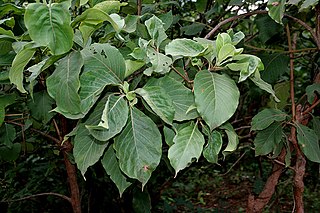
Hymenodictyon is a genus of flowering plants in the family Rubiaceae. It has about 30 species. All are native to the Old World. The wood of Hymenodictyon orixense is soft and has limited use, mostly for boxes. The type species for Hymenodictyon is Hymenodictyon orixense.
Ekmanianthe is a genus of flowering plants in the family Bignoniaceae. It is most closely related to Tabebuia and has sometimes been included within it. It consists of two species of trees, neither of which is especially common in any part of its range:
Van-royena is a genus of the plant family Sapotaceae described as a genus in 1963.

Ceratotheca is a genus of plants in the family Pedaliaceae comprising about five species native to worldwide tropical areas and to southern Africa.

Hypericum patulum, known as goldencup St. John's wort or yellow mosqueta, is a species of flowering plant in Hypericumsect. Ascyreia.
Acrospelion is a genus of flowering plants in the grass family Poaceae, native to central Europe and the Balkans.
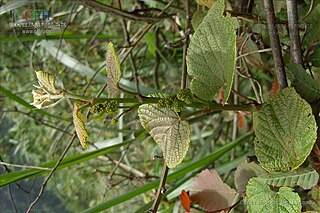
Vitis wilsoniae is a vining plant in the grape family native to China. It is commonly known as the net veined grape or reticulated grape. This species can be found in the provinces of Anhui, Chongqing, Fujian, Gansu, Guizhou, Henan, Hubei, Hunan, Shaanxi, Sichuan, Yunnan, and Zhejiang. The plant grows at altitudes of 400-2000m.
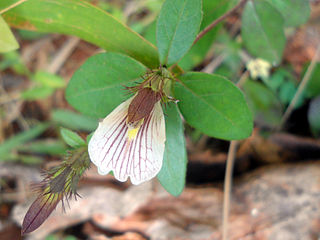
Blepharis maderaspatensis is a species of suffrutescent herb in the family Acanthaceae found in seasonally dry to arid habitats from Africa over Arabia to Southeast Asia.

Pterodiscus is a genus of plant in the Pedaliaceae family comprising several species with a native range from Ethiopia to S. Africa. The range passes through the countries of Angola, Botswana,, Ethiopia, Kenya, Mozambique, Namibia, Somalia, Sudan, Tanzania, Zambia and Zimbabwe. Plus it is found also within the Provinces of South Africa in Cape Provinces, Free State, KwaZulu-Natal and Northern Provinces.
Holubia is a monotypic genus of flowering plants belonging to the family Pedaliaceae. The only species is Holubia saccata.
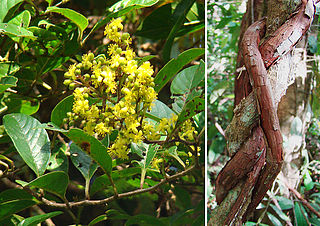
Davilla is a genus of flowering plants belonging to the family Dilleniaceae. It has around 30 neotropical, species and is one of most diverse genera of lianas, vines, erect or scandent shrubs.

Dais is a genus of flowering plants in the family Thymelaeaceae. It is also part of the Gnidia subfamily, along with Gnidia, Drapetes, Kelleria, Pimelea, Struthiola, Lachnaea and Passerina, other genera of species). It is distributed between Tanzania to S. Africa, Madagascar. It is native to the countries of Eswatini, Lesotho, Madagascar, Malawi, Tanzania, Zimbabwe and it is also found within several Provinces of South Africa, such as Cape Provinces, Free State, KwaZulu-Natal and Northern Provinces.

Mollia is a genus of flowering plants belonging to the family Malvaceae. It is within the Grewioideae subfamily, and the Grewieae tribe.

Neogaya is a monotypic genus of flowering plants belonging to the family Apiaceae. It contains just one species, Neogaya simplex, and can be found in Europe, the Alps, the western and southern Carpathians, former Yugoslavia, Belarus. European Russia, Kazakhstan, China, and western Siberia.
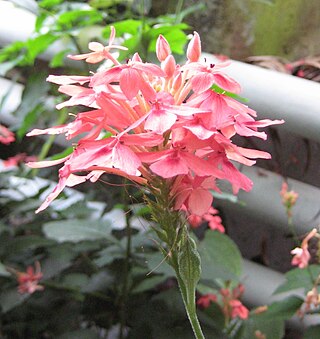
Ruspolia is a genus of flowering plants belonging to the family Acanthaceae.

Samadera is a genus of trees belonging to the family Simaroubaceae, in the order Sapindales. The genus is native to eastern Africa (Tanzania), across to parts of tropical Asia and parts of eastern Australia.














